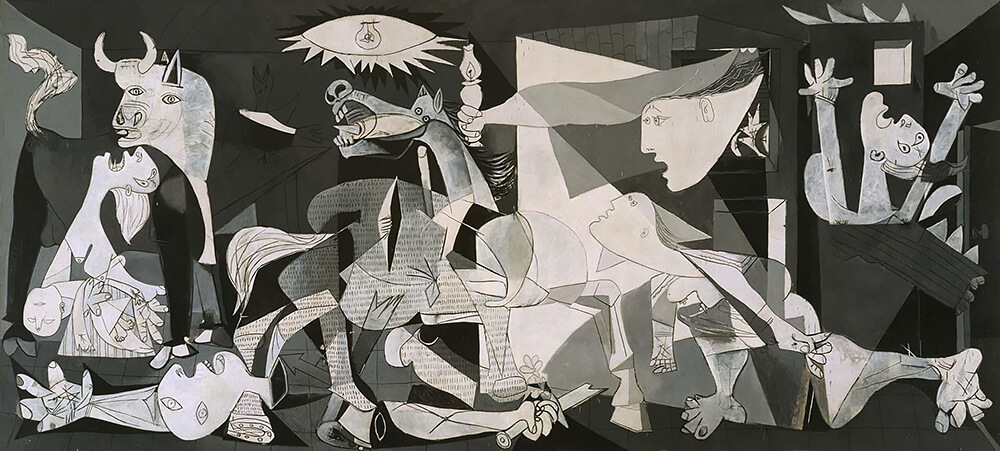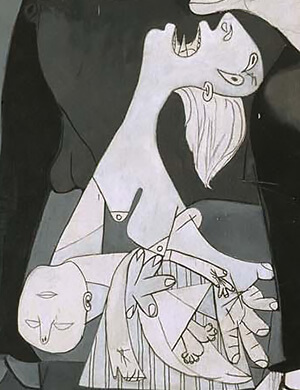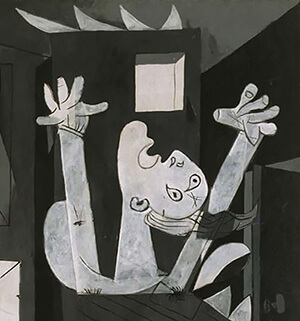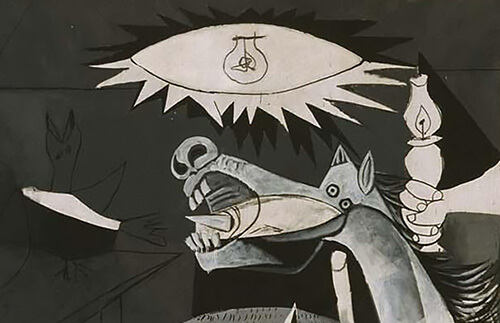Which Statements Describe Cubist Characteristics In This Painting By Pablo Picasso?
Introduction
Created as an anti-state of war protest slice in response to the 1937 aeriform bombing of a modest town in northern Spain, Guernica quickly became one of Pablo Picasso'south most-recognized Cubist paintings—and for very expert reason. Its monochromatic color palette, intense contrast, and large, violent images are visceral, compelling, and unforgettable even today. . . for those who saw information technology in 1937, with international tensions running high and World State of war Ii looming on the horizon, Guernica struck home like a bolt of lightning.

At the time, Picasso was in his mid-50's and living in France rather than Espana, the country of his nascency. As his fame grew, Picasso explored a variety of creative styles, drawing often from Cubism (which he created with Georges Braque) and the Surrealist motility epitomized by Salvador Dali and his famous "melting clocks" painting.
The genius of Guernica is that it successfully combines dreamlike (some might say nightmarish) elements of Surrealism with the multiple-perspectives of Cubism. It was a shocking painting, both for its modern, Cubist style and for its haunting subject matter. After being displayed at the 1937 Globe'southward Fair in Paris, Guernica went on a ii-year "world bout" to encourage anti-fascist sentiment and raise funds for the troops of the Castilian Republic.
When World State of war 2 began in 1939, Guernica left Europe and was sent to New York's Museum of Modernistic Art for safekeeping. MoMA continued to display the massive painting in various US cities and around the world for almost two decades—helping to turn Picasso and Cubism into household names.
It'southward hard to say whether the bombing of Guernica would have gained such international attention without Picasso'southward painting drawing attention to it. Certainly the bombing was an atrocious act of violence—Guernica was a civilian boondocks, deliberately targeted by the NaziLuftwaffe on behalf of their ally, General Francisco Franco, who was leading the rebellion confronting the Castilian Republic.
Yet this blazon of warfare presently became commonplace—proving that, in its own mode, Guernica was nothing short of prophetic: a painting that perfectly encapsulates the inhumanity and horror of modern war, and stands as a timeless warning of what flesh is capable of.
A quick overview of Cubism
To actually understand Guernica, it's important to understand how Cubism differs from other fine art movements. While classical and neoclassical artists might to replicate the earth exactly as it appears in real life (or some perfected version of it) Cubists like Picasso were open to depicting the earth in more abstract ways that offered new, impossible visions of reality.
At its core, Cubism is a method of painting a person, scene, or object from multiple angles. Picasso and Georges Braque developed this technique and used information technology to simplify and distill any 3-dimensional subject into a multi-faceted, "cubist" shape. Picasso was also greatly influenced by the carved, angular shapes of African masks, an inspiration that can be seen in many of his paintings.
These kinds of Cubist artworks—called Analytic Cubism, to differentiate it from a unlike, collage-mode artwork known as Synthetic Cubism—are typically broken upward into geometric segments, occasionally separated by angular lines to course divisions between the various perspectives being shown. While less "geometric" than some of Picasso'due south earlier Cubist pieces, Guernica's flattened, shifting perspectives and simplified color palette are clear earmarks of the Cubist fashion.
Ultimately, Picasso—and Guernica—were both incredibly influential in shifting the fine art world towards modernism and what nosotros now call "abstract fine art."
Analysis of Guernica
Guernica's primary visual impact comes from its collection of maimed and dying figures, rendered in a stark black, white, and gray on a huge sail. We already know about the issue that led Picasso to create this painting (the bombing of Guernica) but he mixed in a lot of symbolism also, conveying deeper pregnant for both himself and the Spanish people.
For our in-depth analysis of Guernica, let's intermission the painting downwards into 3 parts: color and style, symbols, andhuman figures.
Colour and style
 Picasso didn't want to distract from his message by including color, so he eventually made it all stark white, black, and grey. Originally, he'd painted a crimson tear on the woman'due south face, but ultimately decided not to keep it. It makes sense why he did that. . . with no color, there's no relief from what you're seeing, and there's too no unintended (or intended) focal point that way either.
Picasso didn't want to distract from his message by including color, so he eventually made it all stark white, black, and grey. Originally, he'd painted a crimson tear on the woman'due south face, but ultimately decided not to keep it. It makes sense why he did that. . . with no color, there's no relief from what you're seeing, and there's too no unintended (or intended) focal point that way either.
When viewed in person, the unabridged mural-sized painting hits you all at once, with too many visuals to process. The closer you get to it, the more information technology engulfs you in the monstrosities of war.
The centre of the painting especially is a jumble of athwart shapes, cutting across each other with violent energy. Guernica's composition is that of a central triangle of conflict, flanked on the left and correct side past more personal horrors.
The detail in a higher place shows a mother weeping for her dead child on the left. On the right, a figure is engulfed in the flames of a burning building (fifty-fifty more chilling for its dispassionate white and blackness hues).
 I observe the buildings themselves to be absolutely fascinating also—you might miss them at first glance, since they fade into the background backside the screaming figures but the longer you look at Guernica, the more of the phase you'll see.
I observe the buildings themselves to be absolutely fascinating also—you might miss them at first glance, since they fade into the background backside the screaming figures but the longer you look at Guernica, the more of the phase you'll see.
In one spot, a peaked roof is turned on its side. There a building burns. And all around, empty doorways and windows gape like missing teeth and empty center socket in the burned out skull of a city.
While the figures and symbols are a commentary on war in general, and the setting of this painting perfectly represents the town of Guernica, blasted into rubble past the bombs of the Luftwaffe.
Symbols
Placed centrally in the painting, Picasso painted a rearing horse with rolling eyes and distended teeth—its confront is and so anguished, yous can almost hear it scream and you even might miss the spear piercing it from dorsum to front. On the left, a bull seems to baby-sit the mother and child, or perhaps looms over them similar the shadow of the war, while in the distant background, barely visible, a bird shrieks at the sky.
 While the bull may indeed symbolize state of war (or peradventure bullfighting, referencing both Spain in particular and the human desire for authorization in general) I believe the suffering horse is a metaphor for the undeserved death that state of war oftentimes brings to the innocent.
While the bull may indeed symbolize state of war (or peradventure bullfighting, referencing both Spain in particular and the human desire for authorization in general) I believe the suffering horse is a metaphor for the undeserved death that state of war oftentimes brings to the innocent.
Fifty-fifty more telling is the electric bulb casting a harsh light from higher up, in sharp contrast to the hand-held oil lamp. Picasso placed those two elements correct next to each other for a reason:
In a nutshell, he'south showing the harsh reality of progress—for all the good that it brings (electricity, automobiles. . . planes) it besides brings death and destruction.
The homo chemical element
Like the dying horse, the death of the child in its mother's arms symbolizes the suffering of the innocent. And everywhere else in this painting we simply see the atrocities of war. Limbs are huge, bloated and wounded. Mouths gape in soundless screams, eyes are wide in terror, brows are furrowed in ache.
A single warrior lies cleaved and dismembered at the base of operations of the painting, trampled by the death throes of the horse above him. His arm clutches a broken sword, separated from his trunk. In Guernica we find no solace in humanity—all is expiry and destruction.

Picasso painted Guernica over the course of just 35 days, a stunning achievement for such a large work, especially one that has made such a mark in history.
Picasso'southward painting techniques & materials
While Picasso is best-known for his modernistic, abstract paintings, he still learned to draw and paint realistically at a very young historic period. His own style of painting just began to sally when he was xix and living in Paris. It began with his "Bluish Period" (quickly followed by his "Rose Flow") which were named because of the predominantly bluish and pink hues used throughout his paintings at that fourth dimension.
Every bit Picasso began to experiment more with Cubism, he switched to a limited range of oil paints in muted world tones. Today's version of Picasso's Cubist color palette would include colors like Burnt Umber and Burnt Sienna, Yellow Ochre, Titanium White, French Ultramarine Blue, and Ivory Blackness. The creative person himself was said to use the Sennelier make of paints (which had a stiff texture prized by the Impressionists for its ability to make thick daubs on the canvas) and was readily available in Paris at the end of the 19th century.
Read next — How to Add Incredibly Thick Texture to Your Acrylic Paintings
Picasso was also known for finding less "artistic" paints (similar those used in industrial applications) and adding them to his palette likewise. Other non-art objects were pressed into service also: in Guernica, for instance, he added pieces of wallpaper for texture, and at other times he mixed sand into his paint, or bits of newspaper.
A typical Cubist painting by Picasso might kickoff out with a Burnt Sienna background and simple painted outline of his subject. By moving effectually his subject field equally he painted, Picasso was able to layer multiple angles and perspectives into a single image.
Picasso famously referenced his constantly-changing style of painting past saying, "Information technology took me 4 years to paint like Raphael, but a lifetime to paint like a kid."
How much is Guernica worth today?
Guernica has never been sold at auction, then it's value is difficult to determine—given its historical ties to Spain, and the world-wide fame of Picasso, it's unlikely that Guernica will always be sold.
That said, several other paintings by Picasso take sold in recent decades for well over 100 million dollars, so it's easy enough to hypothesize Guernica'due south value. Given the large size of Guernica (compared to Picasso's other paintings) too as its historical and cultural significance, its value would probably exceed 200 1000000 dollars if it went upwardly for auction.
Ownership controversy
Picasso intended for the painting to exist a gift to the people of Spain, just its ownership has at times been the subject field of disagreement. The main reason for this is because in 1937 the Spanish Republic gave Picasso 150,000 French francs to help pay for some of his expenses in creating Guernica (roughly $7,500 or in today'southward dollars, $135,000).
Information technology's unclear whether Picasso considered Guernica "sold" to the Spanish authorities, although sources shut to the artist say he did Not consider information technology a sale. The Spanish government on the other hand, says that they either acquired it, or commissioned information technology in 1937.
Whoever the possessor was at the fourth dimension, Picasso himself chose to display Guernica at the World's Fair in Paris in 1937, as well as various exhibits effectually the world earlier entrusting it to the Museum of Modern Art from 1939 until 1981 (he asked that MoMA go on the painting until Spain was a stable democracy). Accordingly, in 1981 Guernica returned to Spain through an agreement with Picasso's heirs, MoMA, and the Spanish authorities.
Where is Guernica located?
If yous're in Espana, you can see Guernica in person at the Museo Reina Sofia in Madrid. Guernica takes up an entire wall in room 206.06, on the 2nd floor of the Sabatini Building. Admission to the museum costs 10 € and is open weekdays (except Tuesdays) from 10am to 9pm. The museum as well offers reduced hours on Sundays and holidays.
Y'all can also get costless access to Museo Reina Sofia from 7-9pm on weekdays (except Tuesdays) and on Sundays from one:thirty to 7pm.
Source: https://emptyeasel.com/guernica-famous-cubist-painting-by-pablo-picasso/
Posted by: ammonsinho1956.blogspot.com


0 Response to "Which Statements Describe Cubist Characteristics In This Painting By Pablo Picasso?"
Post a Comment